|
This is my dynamic, frequently updated homepage. This is a NewsLog, also known as a WebLog or Blog.
Everything is evolving, so don't assume too much.
People to watch:
Adina Levin
Andrius Kulikauskas
Britt Blaser
Catherine Austin Fitts
Chris Corrigan
Clay Shirky
Dan Gillmor
Dave Pollard
David Allen
David Weinberger
Dewayne Mikkelson
Dina Mehta
Doc Searls
Elisabet Sahtouris
Elizabeth Lawley
Euan Semple
Florian Brody
Frank Patrick
Gen Kenai
George Dafermos
George Por
Graham Hancock
Greg Elin
Hazel Henderson
Heiner Benking
Inspector Lohman
Jean Houston
Jerry Michalski
Jim McGee
Jim Moore
John Abbe
John Perry Barlow
John Robb
Joi Ito
Jon Husband
Jon Lebkowsky
Jon Udell
Jonathan Peterson
Judith Meskill
Julian Elvé
Julie Solheim
Kevin Marks
Lawrence Lessig
Leif Smith
Letecia Layson
Lilia Efimova
Lisa Rein
Marc Canter
Mark Oeltjenbruns
Mark Pilgrim
Mark Woods
Martin Dugage
Martin Roell
Mary Forest
Matt Mower
Max Sandor
Michael Fagan
Mike Owens
Mikel Maron
Mitch Kapor
Mitch Ratcliffe
Nathalie dArbeloff
Netron
Noam Chomsky
Paul Hughes
Peter Kaminski
Phil Wolff
Philippe Beaudoin
Ray Ozzie
Raymond Powers
Rebecca Blood
Roger Eaton
Roland Tanglao
Ross Mayfield
Scott Lemon
Sebastian Fiedler
Sebastien Paquet
Skip Lancaster
Spike Hall
Steven Johnson
Stuart Henshall
Thomas Burg
Thomas Madsen-Mygdal
Thomas Nicholls
Timothy Wilken
Todd Suomela
Tom Atlee
Tom Munnecke
Tom Tomorrow
Ton Zijlstra
Lionel Bruel
Loic Le Meur
Nancy White
Mark Frazier
Merlin Silk
Robert Paterson
Colby Stuart
Nova Spivack
Dan Brickley
Ariane Kiss
Vanessa Miemis
Bernd Nurnberger
Sites to watch:
FutureHi
Co-intelligence Institute
Global Ideas Bank
Collective Intelligence
YES Magazine
Electronic Frontier Foundation
Free Expression Network
Greater Democracy
Independent Media
Disinfopedia
Disinformation
Friendly Favors
Action without borders
Manufacturing Dissent
Explorers Foundation
Imaginify
WorldChanging
Smart Mobs
ThoughtsOnThinking
Disclosure Project
Forbidden Science
Nanodot
Edge
HeadMap
BoingBoing
MetaFilter
Absara
Rhizome
Escape Velocity
Webcamorama
Do No Harm
Junto
NotThisBody
Openworld
Space Collective
Emergent by Design
Collective Web
French:
Emmanuelle
Manur
Elanceur
Loeil de Mouche
IokanaaN
Blog d'Or
Le Petit Calepin
GeeBlog
Absara
Guillaume Beuvelot
Ming Chau
Serge Levan
Jean Michel Billaut
C'est pas Mécanique

I live in Toulouse, France where the time now is:
01:04
Unique Readers:
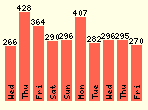
Primarily
Public Domain
Everything I've written here is dedicated to the
Public Domain.

The quotes from other people's writings, and the pictures used might or might not be copyrighted, but are considered fair use. Thus, overall, this weblog could best be described as being:
Primarily Public Domain. |
Syndication:
 ![Validate my RSS feed [Valid RSS]](http://www.newciv.org/pic/valid-rss.png)
|
| Thursday, December 7, 2006 |  |
|
|
|
In 1965 educational psychologist Bruce W Tuckman described 4 stages of group development. The stages are essentially the result of the study of various kinds of small groups in different environments, noticing that they seem to go through certain distinct phases. Which we could say is important in trying to figure out how a group of people might become a community or a team. These are Tuckman's stages:Stage 1: Forming
 Individual behaviour is driven by a desire to be accepted by the others, and avoid controversy or conflict. Serious issues and feelings are avoided, and people focus on being busy with routines, such as team organisation, who does what, when to meet, etc. But individuals are also gathering information and impressions - about each other, and about the scope of the task and how to approach it. This is a comfortable stage to be in, but the avoidance of conflict and threat means that not much actually gets done. Individual behaviour is driven by a desire to be accepted by the others, and avoid controversy or conflict. Serious issues and feelings are avoided, and people focus on being busy with routines, such as team organisation, who does what, when to meet, etc. But individuals are also gathering information and impressions - about each other, and about the scope of the task and how to approach it. This is a comfortable stage to be in, but the avoidance of conflict and threat means that not much actually gets done.
Stage 2: Storming
 Individuals in the group can only remain nice to each other for so long, as important issues start to be addressed. Some people's patience will break early, and minor confrontations will arise that are quickly dealt with or glossed over. These may relate to the work of the group itself, or to roles and responsibilities within the group. Some will observe that it's good to be getting into the real issues, whilst others will wish to remain in the comfort and security of stage 1. Depending on the culture of the organisation and individuals, the conflict will be more or less suppressed, but it'll be there, under the surface. To deal with the conflict, individuals may feel they are winning or losing battles, and will look for structural clarity and rules to prevent the conflict persisting. Individuals in the group can only remain nice to each other for so long, as important issues start to be addressed. Some people's patience will break early, and minor confrontations will arise that are quickly dealt with or glossed over. These may relate to the work of the group itself, or to roles and responsibilities within the group. Some will observe that it's good to be getting into the real issues, whilst others will wish to remain in the comfort and security of stage 1. Depending on the culture of the organisation and individuals, the conflict will be more or less suppressed, but it'll be there, under the surface. To deal with the conflict, individuals may feel they are winning or losing battles, and will look for structural clarity and rules to prevent the conflict persisting.
Stage 3: Norming
 As Stage 2 evolves, the "rules of engagement" for the group become established, and the scope of the group's tasks or responsibilities are clear and agreed. Having had their arguments, they now understand each other better, and can appreciate each other's skills and experience. Individuals listen to each other, appreciate and support each other, and are prepared to change pre-conceived views: they feel they're part of a cohesive, effective group. However, individuals have had to work hard to attain this stage, and may resist any pressure to change - especially from the outside - for fear that the group will break up, or revert to a storm. As Stage 2 evolves, the "rules of engagement" for the group become established, and the scope of the group's tasks or responsibilities are clear and agreed. Having had their arguments, they now understand each other better, and can appreciate each other's skills and experience. Individuals listen to each other, appreciate and support each other, and are prepared to change pre-conceived views: they feel they're part of a cohesive, effective group. However, individuals have had to work hard to attain this stage, and may resist any pressure to change - especially from the outside - for fear that the group will break up, or revert to a storm.
Stage 4: Performing
 Not all groups reach this stage, characterised by a state of interdependence and flexibility. Everyone knows each other well enough to be able to work together, and trusts each other enough to allow independent activity. Roles and responsibilities change according to need in an almost seamless way. Group identity, loyalty and morale are all high, and everyone is equally task-orientated and people-orientated. This high degree of comfort means that all the energy of the group can be directed towards the task(s) in hand. Not all groups reach this stage, characterised by a state of interdependence and flexibility. Everyone knows each other well enough to be able to work together, and trusts each other enough to allow independent activity. Roles and responsibilities change according to need in an almost seamless way. Group identity, loyalty and morale are all high, and everyone is equally task-orientated and people-orientated. This high degree of comfort means that all the energy of the group can be directed towards the task(s) in hand. I've certainly noticed these steps in action. Is it the only way it can happen? I'm not sure. And even though one can outline stages, it is not a given that one will know how to get from one to the other. But identifying where one is at can be a step forward in itself.
In 1977 Tuckman refined his model and added one more step: Stage 5: Adjourning
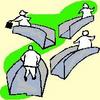 This is about completion and disengagement, both from the tasks and the group members. Individuals will be proud of having achieved much and glad to have been part of such an enjoyable group. They need to recognise what they've done, and consciously move on. Some authors describe stage 5 as "Deforming and Mourning", recognising the sense of loss felt by group members. This is about completion and disengagement, both from the tasks and the group members. Individuals will be proud of having achieved much and glad to have been part of such an enjoyable group. They need to recognise what they've done, and consciously move on. Some authors describe stage 5 as "Deforming and Mourning", recognising the sense of loss felt by group members.
Hm, interesting to put that as a stage. It is right of course. Sometimes one's membership of a group doesn't totally fall into place before the group members more or less have moved on to something else.
There are lots of versions of Tuckman's model on the net. This one is from here.
[ Patterns | 2006-12-07 21:07 | | PermaLink ] More >
|
|
| Wednesday, December 6, 2006 |  |
|
|
|
  
Bert Simons is an artist, and being in a bit of a midlife crisis, worried that he wasn't leaving enough of himself behind in the world, he decide to clone himself. By computer-generating a model of his head, and producing it in paper strips that can be assempled into a close likeness of himself. And after that, he started working on the perfect cardboard woman.
[ Culture | 2006-12-06 21:51 | | PermaLink ] More >
|
|
|
|
US Dept. of Energy: ...with DOE funding, a concentrator solar cell produced by Boeing-Spectrolab has recently achieved a world-record conversion efficiency of 40.7 percent, establishing a new milestone in sunlight-to-electricity performance. This breakthrough may lead to systems with an installation cost of only $3 per watt, producing electricity at a cost of 8-10 cents per kilowatt/hour, making solar electricity a more cost-competitive and integral part of our nation’s energy mix. That's very good news. But there's something kind of perverted about converting it to a cost per kWh, as if that makes it an even comparison with pumping oil out of the ground and burning it. Anyway, as somebody on Slashdot calculates, that should mean that a square 265 miles on a side in the American southwest could handle the whole world's energy needs.
[ Science | 2006-12-06 22:04 | | PermaLink ] More >
|
|
|
|
I haven't used Microsoft SharePoint, but Euan's Commentary on why he doesn't like it applies more widely:If social computing is going to be effective in the workplace things have to be different - fundamentally.
When we started building this stuff at the BBC we were consciously trying to build the online equivalent of a collection of Cotswold villages with lots of footpaths between them. You know where the pub and church are, you’re comfortable in the environment and you can locate yourself. Corporate systems tend to be more like Milton Keynes. On the surface they’re efficient with lots of straight lines and signposting, but you get lost because everything looks the same.
Using a new tool really does feel like walking into a room and working out what the atmosphere is like, what the other people are like, whether they feel like people I could get on with and whether we will be allowed to take our time to form a relationship and begin to get things done. Dave Snowden was right when he said that you can’t manage knowledge but you can create a knowledge ecology.
I can't put my finger in what it is - the graphics, the language used or the intentions behind the software but I rarely get this feeling from Microsoft stuff especially not SharePoint. They are too good at creating sterile environments run by control freaks who hate messiness, consider conversations unprofessional and rarely understand the true pulse of their organisations.
This stuff may be seen as "business-like" at the moment but I don't believe it will be what business is like in the future. I hope not. Here's to human business networks.
[ Knowledge | 2006-12-06 22:22 | | PermaLink ] More >
|
|
| Tuesday, December 5, 2006 |  |
|
|
|

Metafilter: Barcelona Street Art. Most places consider graffiti a form of vandalism, but in Barcelona, street art is embraced. The result is a city with public walls like giant canvases of modern art.
[ Culture | 2006-12-05 16:06 | | PermaLink ] More >
|
|
|
|
 Hey, I just notice that I'm still #1 in a Google search for "Western Union Sucks" and "Budget Sucks". Hey, I just notice that I'm still #1 in a Google search for "Western Union Sucks" and "Budget Sucks".
Not that I'm particularly in the business of bad-mouthing others, but I do find it to be a wonderful balancing factor that anybody who feels they've been screwed over by some Big Soulless Corporation can simply talk about it on their own website and grab a part of the mindshare. Of course it helps a bit if one has a blog with PageRank 7.
If you didn't already know, whenever you would like to check out how clean a certain company is, searching for "[company name] sucks" in Google will give you a bit of a clue. OK, sometimes people badmouth companies for no fair reason, but if you find lots of entries from different people, you might catch wind that there might be some problems with their practices.
As you can see in the comments to my Western Union post, there's no lack of other people who've had the exact same experience. In brief, what happened to me was that I needed to transfer some money quickly, and they accepted the order, charged the money from my bank account immediately, and then later sent me an e-mail to call them, after which they presented me with a "security" interview, confronting me with erroneous 15 year old credit report entries on me, and when I didn't agree with them, they denied my transfer, and then took 10 days to refund my money. So much for "money in minutes".
And don't get me started on Budget Rent-a-car.
[ Diary | 2006-12-05 16:08 | | PermaLink ] More >
|
|
|
|
If you're in the market for a Content Management System, and OSCOM or OpenSource CMS are too complicated for you, then maybe you just need the complexity translated into terms you can understand, like in Content Management Systems I Would Or Wouldn’t Fuck, by Jason Stratham:Would: - Vox - The Japanese schoolgirl of content management systems, practically begging for you to stalk it on Myspace or rub up on it in the subway.
- Drupal - The exotic foreign exchange student. If you can figure out what the hell language it speaks, it’ll be so greatful for the attention it’ll bend over backwards and let you do whatever you want to it.
Wouldn’t: - Blogger - Really popular, and consequently has every virus known to science.
- Wordpress - High maintenance; you have to read a lot of documentation in order to do it right. Always leaves you wondering if you should have used different plug-ins.
- Movable Type - Looks like it used to be a lot of fun when it was younger; now it just sort of lays there and doesn’t do much. Takes forever to refresh. Spends most of its time changing in and out of different outfits.
- Livejournal - The CMS most likely to be into Harry Potter bloodplay.
- Textpattern - Looks very attractive and willing, but beware. Textpattern whispers in your ear “I’ll do whatever you want. Come on, touch me here,” and you touch it there and it DIES.
Hm, but what if I just want a candlelight dinner and snuggle in front of the fireplace kind of thing, what's my CMS?
[ Technology | 2006-12-05 18:08 | | PermaLink ] More >
|
|
| Monday, December 4, 2006 |  |
|
|
|
Granularity for students, by Michael Leddy, gives some good advice on breaking things down.People who think about hacking their lives and their work often speak of “granularity.” It’s a curious word. The online Oxford English Dictionary offers only “granular condition or quality” as a definition. A more helpful definition comes from the National Center for Supercomputing Applications: “The extent to which a larger entity is subdivided. For example, a yard broken into inches has finer granularity than a yard broken into feet.” To think of tasks and challenges in terms of granularity is to think in terms of breaking them down into smaller and more manageable parts.
Granularity is a tremendously useful strategy for students. The typical spiral-bound student-planner doesn’t seem to encourage it; that tool is often little more than a place to store due dates: “research paper due.” But no one can just write a research paper. That paper can only be the result of numerous small-scale tasks. It’s not surprising that students who think of “write research paper” as one monolithic task are likely to put it off far longer than they ought to. Instead of “write research paper,” one could think of these tasks: go to library to look up sources; organize them by call number; read first three sources and take notes; get article from JSTOR; read remaining three sources and take notes; organize notes on computer; check bibliography format; ask professor about endnote form; make rough outline; and so on. Each of these “granular” tasks is far more do-able than “write research paper.” Thinking of work in terms of granularity can be one way to overcome the overwhelming dread of getting started. And keeping track of such tasks on paper and crossing them off one by one gives the satisfaction making progress and getting closer to done.
A student might also apply the strategy of granularity to the work of writing itself. Instead of writing a draft and “looking it over,” it’s much smarter to break down the work of writing and editing by thinking about one thing at a time. Developing a strong thesis statement: that’s one task. Working out a sequence of paragraphs to develop that thesis: another task. Figuring out how to make a transition from one paragraph to another: another task. If you tend to have patterns of errors in your writing, look for each kind of error, one at a time. Noun-pronoun agreement? Read a draft once through looking only for that. Comma splices? Read once through with your eyes on the commas. It might seem that approaching the work of writing and editing in terms of smaller, separate tasks is unnecessarily cumbersome, but breaking things down will likely make it far easier to work more effectively and come out with a stronger piece of writing. No writer can think about everything at once.
Granularity is also a useful strategy for making even a daunting reading project do-able. If you have eighty pages to read, finish twenty and take a short break; then repeat. If you’re reading James Joyce or Marcel Proust, a handful of pages might be all that you can manage at one sitting, and sometimes you might need to chart your progress by the sentence. But those sentences and pages add up, and I should know. I just finished all seven volumes (3,102 pages) of Proust’s In Search of Lost Time (À la recherche du temps perdu), averaging twenty pages a day over five months and two days of reading. (Via BoingBoing).
I suppose we can say that one can accomplish just about anything, if one can break it down into small, managable tasks. Many people will fail in doing something big they really could do, simply because they don't break it down into things they can start doing right now. Something big and fuzzy will seem impossible. But often there will be a small thing you can do right now, or today, and another piece tomorrow, and sooner or later you're there.
[ Patterns | 2006-12-04 20:38 | | PermaLink ] More >
|
|
|
|
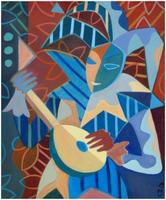 If you're planning to write something like a constitution, you might want to adopt the guideline that it needs to be singable. Singable? Yeah, why not? Good songs have certain inherent qualities which we intuitively recognize. Like good stories, they sometimes succeed in making complexity easily understandable. Tony Judge makes the point in A Singable Earth Charter, EU Constitution or Global Ethic. Here are some guidelines for songs as applied to writing a constitution: If you're planning to write something like a constitution, you might want to adopt the guideline that it needs to be singable. Singable? Yeah, why not? Good songs have certain inherent qualities which we intuitively recognize. Like good stories, they sometimes succeed in making complexity easily understandable. Tony Judge makes the point in A Singable Earth Charter, EU Constitution or Global Ethic. Here are some guidelines for songs as applied to writing a constitution:- Needs to be short -- but able to embody a complex pattern of information (in the light of advances in auditory display and sonification)
- Needs to be memorable -- especially in the sense of its function of "re-membering" a divided society
- Needs to offer reminders of significant relationships between matters that may otherwise be treated as dangerously unrelated -- vital feedback loops from a systemic control perspective
- Needs to be attractive in the context of a complex social system -- especially according to the new understanding of "strange attractors" in the complexity sciences
- Needs to strike a balance between the dysfunctional symbolic extremes of:
- the Ode to Joy, adopted as the anthem of Europe -- appealing primarily to the older generation, if only because of its classical quality, exemplifying the democratic challenge that admiration does not necessarily enable participation
- the overwhelming popular winner of the Eurovision Song Contest in 2007 (Hard Rock Hallelujah) -- a heavy metal band in monstrous demonic guise, appealing significantly to the younger generation [video]
- the 300-pages of the legal text of the proposed European Constitution [more] -- unreadable, and therefore incomprehensible, to most EU citizens (and perhaps deliberately so)
- Capable of being refreshed periodically, if not annually, in the light of new insights, challenges and opportunities -- and if only in recognition of the limitations of any previous version
- Inviting participation, if not entraining it -- as a contrast to the apathy-reinforcement characteristic of modern political discourse
- Inherently imaginative -- reframing the past, offering new significance to the present, and pointing to new ways of thinking about the future
- Challenging to cognition -- an element of puzzle and mystery to be "solved", as with many computer and other games in which there is a gestalt to be recognized (possibly even at several levels)
- Imminently practical in its elaboration -- as with the procedures for open competition for major architectural or other design projects
- Susceptible to animated accompaniment -- with possibilities of exemplification through multi-media techniques and gaming simulations
- Embodying systemic understandings valuable to governance at all levels -- and consonant with experience at those levels
It is a brilliant connection to make. And so simple, really. If it doesn't make a good song, it probably doesn't make a good constitution. Yeah, nobody could understand that 300 page EU constitution, so they didn't like it. If it would have been in a format that played well on the radio, and if people actually liked it, no sweat, of course they would have voted for it.
Cognitive engagement with complexity. Yeah, we need more of that. And you don't make complex things palatable just by over-simplifying them and leaving things out. But you can make them available by representing them in formats that more naturally convey complexity. You know, like a picture is worth a thousand words. And like a song or an orchestral piece can convey something very complex, which one actually might "get" and remember, more or less, afterwards. What's efficient in terms of communication in a picture is not the large number of pixels. Rather it is that you can see how it all fits together. You don't remember 2 million pixels and their color values, you remember the patterns, because they make sense.
A common mnemonic trick is to remember something based on a story. Say you're asked to memorize 100 numbers or random items. Unless you're an autistic savant, you probably can't do that. But, with a little practice, you can learn to do so by constructing a story around the items or the numbers. A story is much easier to remember than a list of random stuff. The compression rate is much higher. But you can turn the story around and bring back those random items.
One idea, or one metaphor, or one photograph might bring forward large amounts of related thoughts, feelings, ideas, etc. It is like a fractal compression thing. You get the pattern that ties it all together, and then you just need to remember one thing, rather than 100.
You're constantly being bombarded with both good and bad examples of that. Advertising will often try to use your few seconds of attention to convey a whole package of meaning and feelings, to make you change your behavior and go and buy whatever they want you to buy.
And law makers and university professors will often ask you to do the impossible: making sense out of thousands of random items, without ever giving you the fractal algorithm that would wrap them into something simple and understandable. Quite possibly because they didn't think about it, or they wouldn't know what it would be. And quite possibly because what they're trying to present really just is thousands of random items.
So, instead they should think of singing it. And if they're having trouble with that, they maybe should get back to the drawing board and make something that actually is coherent.
And we can learn something from past masters of integrating different cognitive realms and modes of communication into good tunes, like ... the troubadours. One early example is the work promoted by the Cathars through the troubadours and trouvères, highly sophisticated verse-technicians, whose music and poetry combined in the service of the courtly ideal of love:
"Modern European literature originated in Occitania in the early 12th century. It was started by hundreds of Troubadours (poet-musicians), who sang the praises of new values and in a new way. Their themes were courtly love, and concepts such as "convivencia" and "paratge" for which there is no modern counterpart in modern English or French. "convivencia" meant something more than conviviality and "paratge" meant something more than honour, courtesy, chivalry or gentility (though our concepts of honour, courtesy, chivalry and gentility all owe something to the concept of "paratge". They praised high ideals, promoting a spirit of equality based on common virtue and deprecating discrimination based on blood or wealth. They were responsible for a great flowering of creativity." (The Troubadours) Of course Occitania is right here, south-western France. Cathar country. So, I'm always happy to hear about that. The troubadours might mostly be remembered now as simply some guys who sang songs, but, yes, it was really a lot deeper than that. Subversive communicators of new values. But, hey, that's indeed because song can be an effective vehicle for such.
So, public leaders better start singing. Or somebody else will.
[ Politics | 2006-12-04 21:42 | | PermaLink ] More >
|
|
| Sunday, November 19, 2006 |  |
|
|
|
Thingamy. This is what it says on the site:One single system to run your business.
No need for other enterprise software nor middleware.
No need for hierarchies nor information tree structures.
No need for management to run the workflow.
Enter the future at your own pace, start small or big.
Refine your business model and processes continuously.
And yes, you're not the first to utter unbelievable, bollocks, bullshit, etc. under your breath.
We like that, leaves us only one task: Prove that the system actually works.
Would that not be kind of cool if we did?
And what is it? Well, it is a piece of software, which apparently one can model any kind of business process in, very quickly, and then you have the application to run your business right away. So, seems like you can create your Enterprise Resource Planning system in a few hours, and it would do ordering and accounting, etc. It is based on some kind of object-oriented, rules-based database thing, that is also a webserver, with an Ajax interface.
I watched the introductory video. Which indeed shows that you can do something like that very quickly, and one gets the idea that it is basically made of simple building blocks. But it is also very complicated to do, as it was in no way clear how exactly to do it, and the components weren't really explained.
But this is the kind of application I've tried to write several times. A universal application with simple building blocks that lets you create any kind of application, and it is operational right away. But it is very hard to make something that really is universal. And if you more or less succeed, it might be very hard to explain it to anybody. Which might become the problem with this Thingamy thing.
It doesn't seem to have been released yet, so I can guess it maybe is hard to get all the details right. And maybe it promises too much. It sort of implies you can create your business based on this. Focus on the value you offer, and Thingamy will easily take care of all the details. Of course it isn't quite that easy.
But I'm looking forward to seeing where it is going.
[ Programming | 2006-11-19 21:30 | | PermaLink ] More >
|
|
|
|
AndroidTech, Web 3.0 - You Ain't Seen Nothing Yet!. Isn't it a little early to try to say what Web3.0 is, when we haven't entirely agreed what Web2.0 is? I guess not. I feel that Web 3.0 will be characterized and fueled by the successful marriage of artificial intelligence and the web. Artificial Intelligence? Isn't that the kool-aid that the Semantic Web community is drinking? Yes and no. The technologies considered pivotal in the Semantic Web are indeed considered by many to have their underpinnings in artificial intelligence. But, most of the Semantic Web projects I've seen are focused squarely on the creation of, and communication between, intelligent agents that do the natural language and topical matching work in a transparent manner, behind the scenes, without requiring human intervention.
This approach may eventually be viable but I feel that it misses a key ingredient of Web 3.0 that will finally bring artificial intelligence to the forefront. Currently the vast majority of artificial intelligence is embedded in various niche areas of commerce such as credit card fraud detection, or the speech recognition application that converts your voice to text as you dictate a document, etc. The reason for this of course is that we are still decades away from computers that will have the incredible and flexible pattern recognition capabilities of the human brain. Well, right, yeah. Artificial Intelligence looked very promising 30 years ago, and it maybe still does, but I haven't noticed much progress, other than that faster computers can make something look a bit intelligent by brute force. But what he's thinking about is not really AI, but this kind of thing: The reason Web 3.0 will lift artificial intelligence into the limelight is it will fill in the technological gaps that currently hamper the key uses for artificial intelligence. It will do so by shunting out the parts of the problem that require a human being to human beings with the help of the web. But, it will do so in a manner that is transparent, massively parallel, and distributed.
Amazon has taken a unique and innovative step into this area with their Mechanical Turk web service. Yes I know this is the second time I've written glowingly about Amazon in regards to Web 3.0, but as a web service junkie you have to love what they are doing. The Turk service allows developers to shunt out the parts of their applications that require human intervention to a paid participating group of volunteer workers, in a manner that mimics a standard web service call. This creates a standardized platform for utilizing human pattern recognition capacity in a modular manner. Google is another company experimenting with something similar with their Google Image Labeler game. From the game page:
"You'll be randomly paired with a partner who's online and using the feature. Over a 90-second period, you and your partner will be shown the same set of images and asked to provide as many labels as possible to describe each image you see."
The players have fun and Google gets thousands of images tagged with relevant text labels. Wow, I have played that, and I didn't even get the point. That's brilliant, of course. Use human intelligence for something productive, have fun, or get paid for it.
That might somehow become an important trend. But that's essentially a Web2.0 kind of thing, to individually tag stuff and to collectively produce a bunch of ordered stuff.
I'd hope Web3.0 would be a cyberspace kind of thing. I mean cyberspace as flying around in multi-dimensional space and all the data you need and want being layed out visually in a way that's useful to you. "Computer, show me all the people I know, sorted by hair color!" But we're kind of far off from that, as computers still operate with a desktop metaphor, with filing cabinets and documents. And even 3D environment mostly just try to look like the regular 3D world with added improvements. Looking at a webpage on a virtual screen in a virtual world doesn't make it any better at all. We need something with more dimensions, and where you actually can look at enormous amounts of data in a useful and intuitive way. But maybe that's too much to ask, and maybe that'll be Web9.0 or something.
[ Information | 2006-11-19 22:27 | | PermaLink ] More >
|
|
| Saturday, November 18, 2006 |  |
|
|
|

From here A new image from NASA's Spitzer and Hubble Space Telescopes looks more like an abstract painting than a cosmic snapshot. The masterpiece shows the Orion nebula in an explosion of infrared, ultraviolet, and visible-light colors. It was "painted" by hundreds of baby stars on a canvas of gas and dust, with intense ultraviolet light and strong stellar winds as brushes.
At the heart of the artwork is a set of four monstrously massive stars, collectively called the Trapezium. These behemoths are approximately 100,000 times brighter than our sun. Their community can be identified as the yellow smudge near the center of the composite.
The swirls of green were revealed by Hubble's ultraviolet and visible-light detectors. They are hydrogen and sulfur gases heated by intense ultraviolet radiation from the Trapezium's stars.
Wisps of red and orange detected by Spitzer indicate infrared light from illuminated clouds containing carbon-rich molecules called polycyclic aromatic hydrocarbons. On Earth, polycyclic aromatic hydrocarbons are found on burnt toast and in automobile exhaust.
Additional stars in Orion are sprinkled throughout the image in a rainbow of colors. Spitzer exposed infant stars deeply embedded in a cocoon of dust and gas (orange-yellow dots). Hubble found less embedded stars (specks of green) and stars in the foreground (blue). Stellar winds from clusters of newborn stars scattered throughout the cloud etched all the well-defined ridges and cavities.
Located nearly 1,500 light-years away from Earth, the Orion nebula is the brightest spot in the sword of the hunter constellation. The cosmic cloud is also our closest massive star-formation factory, and astronomers suspect that it contains about 1,000 young stars.
The Orion constellation can be seen in the fall and winter night skies from northern latitudes. The constellation's nebula is invisible to the unaided eye, but can be resolved with binoculars or small telescopes.
This image is a false-color composite, in which light detected at wavelengths of 0.43, 0.50, and 0.53 microns is blue. Light with wavelengths of 0.6, 0.65, and 0.91 microns is green. Light of 3.6 microns is orange, and 8-micron light is red. Bigger size image here
[ Science | 2006-11-18 13:27 | | PermaLink ] More >
|
|
|
|
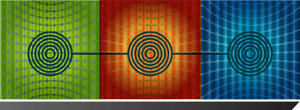 The Center for Collective Intelligence is a new academic center at MIT. This is their basic research question: The Center for Collective Intelligence is a new academic center at MIT. This is their basic research question: How can people and computers be connected so that—collectively—they act more intelligently than any individuals, groups, or computers have ever done before? Ah, very good news. They start with observations like how Google or Wikipedia manage to pool the wisdom of many people in ways that often are better than what any individual or traditional group could accomplish. They have projects focusing on such things as: How can large groups of people produce high quality written documents? For instance, how can the lessons of Wikipedia be applied to other groups and other kinds of documents? What kinds of technologies and motivational structures are needed?
How can groups of people make accurate predictions of future events? For instance, in prediction markets, people buy and sell predictions about uncertain future events, and the prices that emerge in these markets are often better predictors than opinion polls or individual experts. When and how do these prediction markets work best? How can they be combined with simulations, neural nets, and other techniques?
How can we harness the intelligence of thousands of people around the world to help solve the problems of global climate change? For instance, how can we use innovative combinations of computer-based simulations and explicit representation of argumentation to help people identify and analyze different policy alternatives?
How can we create an on-line, searchable library of books from many languages and historical eras? For instance, how can we harness a combination of human and machine intelligence to recognize the images of words in these books?
How can we help create commercially sustainable products and services for low-income communities around the world? For instance, how can we use cutting-edge technology to help a world-wide network of entrepreneurs and investors rapidly find, analyze, and replicate successful projects?
And they're working on a book called We are smarter than me. And I learned of this, of course, via Blog of Collective Intelligence.
[ Knowledge | 2006-11-18 18:12 | | PermaLink ] More >
|
|
|
|
LA Times: An international team of scientists reported Thursday that rising temperatures are steadily transforming the Arctic -- warming millions of square miles of permafrost, promoting lush greenery on previously arid tundras and steadily shrinking the annual sea ice.
Yet the researchers also found new patterns of cooling ocean currents and prevailing winds that suggested the Arctic, long considered a bellwether of global warming, may be reverting in some ways to more normal conditions not seen since the 1970s.
Taken together, these findings may be evidence, the researchers said, of the region struggling to keep its balance, as rising temperatures slowly overturn the long-established order of seasonal variations.
"This is a region that is fighting back," said lead author Jacqueline Richter-Menge, a civil engineer at the Cold Regions Research and Engineering Laboratory in Hanover, N.H. "There are things that showed signs of going back to norms, trying to right themselves under very dire circumstances."... I'm glad the arctic seems to have a mind of its own.
[ Science | 2006-11-18 20:45 | | PermaLink ] More >
|
|
| Sunday, November 5, 2006 |  |
|
|
|

This is a NASA picture from here of sunset over Europe and Africa. Digitally composited.
Which I'm thinking of because there was a power failure here last night, which affected big chunks of Europe. It was only 45 minutes or so here in Toulouse, but long enough to start a fire in the fireplace, have cocoa, and spend a cozy time while the computers and the TVs were off.
[ Diary | 2006-11-05 19:56 | | PermaLink ] More >
|
|
|
|
Jon Udell mentions Dabble DB: The October episode of The Screening Room features Dabble DB, a web-based workgroup database that, in the style of 37Signals, focuses on simplicity and embraces constraints. Dabble doesn't aim to do full-blown database application development, or sophisticated query, or heavy transactions. Its mission, instead, is to enable teams to easily manage and flexibly evolve modest (say, 30- to 50-megabyte) quantities of structured data. Now, Dabble is first of all cool, but that brings up several things. Dabble is a database you create on the fly online, which you very easily can import stuff into, particularly from spreadsheets, and you can very easily change it around, add fields, etc. And it is often intelligent enough to figure out what you might want to do, and making it easy.
That reminds me first that I made a program like that several years ago, where you create a database online, and you can change it on the fly, and import stuff into it, and you automatically have screens for searching, sorting, updating it, etc, and you don't need to know much about databases. My web app isn't nearly as cool, doesn't do any Ajax tricks, and doesn't make it nearly as easy. There are people using my app, who're happy with it, but I never got it to a point where it would be meaningful to market it.
That's a bit of a puzzle I have as a programmer. Should I make a bunch of different functionalities that are tied together, but spread myself so thin that it ends up being a bit mediocre and not quite finished? Or should I get a team together and do it better? Or, should I do what is the current Web2.0 fashion - do one rather simple, limited thing, but make it very cool and easy to use, and then charge people per month for using it.
As he says, focus on simplicity and embrace constraints. Make it very simple, refuse the temptation to add more advanced features. Make the simplicity and lack of features BE a feature.
Like 37 Signals, obviously. Very smart people making very simple programs, even bragging about how quickly they made them, but making them so well that they're very intuitive to use, and so compelling that thousands will happily spend $10 per month for using one of them.
I'm trying to talk myself into it... Intellectually I get it, but instinctively I'd tend to go for a too-complicated solution, when a more simple would do.
My pet programming project the last couple of years has been a collaborative environment I call OrgSpace, which has wikis, blogs, calendars, forums, chat rooms, project management, contact lists, event management, databases, a shopping cart, workgroups, and more, all integrated with each other. But that makes it so damned complicated that it is a bit crazy to try to do single-handedly.
And some of the things I've done successfully have been very simple. Like the webcam thing I did in Opentopia. Took me not much more than a weekend to do, but it has gotten more hits than anything else I've put on the web. I recently sold that website, and it all sort of speaks for the idea of doing simple and cool things and getting them out the door.
So, I'm trying to meditate on that simplicity-and-embracing-constraints message.
It is like The Mythical Man-Month. Complexity grows exponentially as, uhm, things get more complex. When a software project grows so complicated that one person can't easily understand all of it at one time, the need for communication between team members makes it quickly mushroom way out of proportion. A small team of 3-5 people can be very productive, but anything beyond that starts getting crazy. For that matter, even if it is a one-person project, if he can't easily comprehend the total project at the same time, it gets too complex as well.
Scaling it up much further, how about understanding and solving humankind's problems? Does some committee need to somehow solve the big problems together, even though they have a hard time understanding the full system? Or is it maybe better if small groups of people solve very specific and limited problems, but they solve them so well that their piece becomes a fine building block for bigger solutions, which they maybe can't even imagine.
I could say that this is maybe nature's way of dealing with complexity. A whale is very good at being a whale and plankton is very good at being plankton, but none of them lose any sleep over pondering the complexities of the ecosystem. And yet they're integral parts of it. If they made a big committee, they probably wouldn't do as good a job at it.
It could be a human type of hubris that we think it is our job to come up with big general solutions for complex problems we don't really understand. Rather than coming up with elegant and complete solutions to small problems that we do understand. I'm not sure. Just a philosophical thought.
[ Knowledge | 2006-11-05 20:36 | | PermaLink ] More >
|
|
| Thursday, November 2, 2006 |  |
|
|
|
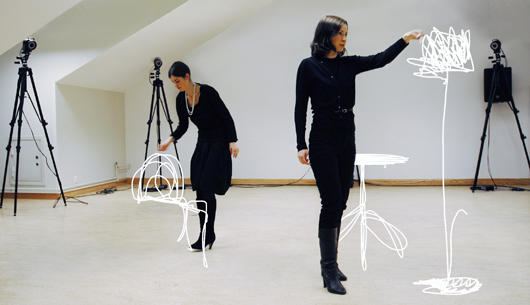
Sketch FurnitureIs it possible to let a first sketch become an object, to design directly onto space?
The four FRONT members have developed a method to materialise free hand sketches. They make it possible by using a unique method where two advanced techniques are combined.
Pen strokes made in the air are recorded with Motion Capture and become 3D digital files; these are then materialised through Rapid Prototyping into real pieces of furniture. Very cool. Yeah, that makes it feel a little like we're actually living in the 21st century. (Via BoingBoing)
[ Culture | 2006-11-02 16:34 | | PermaLink ] More >
|
|
|
|
 CNN: CNN:PARIS, France (AP) -- An elderly couple waltzes to the steady carnival music of an organ grinder on the dingy platform of a Paris subway station. But it's nearly 3 a.m., and the station has been closed since World War II.
They are part of a traveling nocturnal party that barrels through the tunnels of the Metro long after the passenger trains have been tucked away for the night. These riders are on an exclusive, all-night Metro history tour, organized a dozen times a year by a group of railway buffs.
The ADEMAS association, dedicated to restoring old trains and preserving the Metro's history, has been around since 1992. (ADEMAS stands for Association D'Exploitation du Material Sprague; the Paris Metro's Sprague-Thomson model cars date to the early 1900s.)
But until recently, the group was as mysterious as the phantom stations they visit on their tours.
Rumors about the all-night Metro rides circulated by word of mouth and in Internet chat rooms, but details were almost impossible to track down -- until June, when ADEMAS launched its Web site. But even that lacks specific times and tour dates.
Association president Julian Pepinster says it's with good reason. There are just 2,400 spots available each year.
"There's a constant demand for the tours," he said in an interview. "Even with a dozen tours a year, there's always a six-month wait."... Cool. I wanna do that. More here or here.
[ History | 2006-11-02 17:44 | | PermaLink ] More >
|
|
| Friday, October 27, 2006 |  |
|
|
|
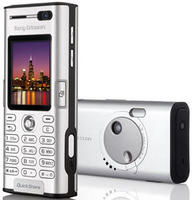 Sometime last month I was bored and decided to check what my mobile phone actually could do. It is not an expensive phone, but a rather recent one with 3G. Which means it can access the net with a useful bandwidth and it has video and stuff like that. So, it can be a video phone for one thing. But actually I didn't run into anybody I had a chance to try that with. But it can also just play videos. There's a bunch of TV channels, and there are music videos and stuff like that. So I watched some of those, and clicked around a little bit to see what was there. I think I spent an hour doing that. Pretty crummy on a small screen like that, but I thought it was cool that it could do that. Until I got the bill, that is. I had accepted a €4 charge for some categories of videos, all I want, all day, which sounded ok, and I expected to see that on my bill. Plus, I imagined I might be using up my calling minutes. But, no, that hour of poking around in stuff I thought was largely free cost me over 100 euros. The killer was the billing by kilobyte, at a ridiculously high rate. Which means one has to be pretty insane to sit and watch crummy videos at several euros per minute. So, one thing is to have fancy technology. Another is that it might be billed in such a way that it is totally useless. Having a 3G phone essentially gives me nothing. Sometime last month I was bored and decided to check what my mobile phone actually could do. It is not an expensive phone, but a rather recent one with 3G. Which means it can access the net with a useful bandwidth and it has video and stuff like that. So, it can be a video phone for one thing. But actually I didn't run into anybody I had a chance to try that with. But it can also just play videos. There's a bunch of TV channels, and there are music videos and stuff like that. So I watched some of those, and clicked around a little bit to see what was there. I think I spent an hour doing that. Pretty crummy on a small screen like that, but I thought it was cool that it could do that. Until I got the bill, that is. I had accepted a €4 charge for some categories of videos, all I want, all day, which sounded ok, and I expected to see that on my bill. Plus, I imagined I might be using up my calling minutes. But, no, that hour of poking around in stuff I thought was largely free cost me over 100 euros. The killer was the billing by kilobyte, at a ridiculously high rate. Which means one has to be pretty insane to sit and watch crummy videos at several euros per minute. So, one thing is to have fancy technology. Another is that it might be billed in such a way that it is totally useless. Having a 3G phone essentially gives me nothing.
Sometimes it is the same thing with WiFi accesss points. Recently, when I didn't have my internet connection yet, I drove around and looked for public WiFi access points. And there's one close by, at the Comfort Inn in Ramonville. It is run by Orange, which is my cell phone provider, so in principle, it should be no problem. Except for that it bills at cell phone per-minute rates. Which means it would be around €15 per hour. Might make sense for an emergency, to quickly check my e-mail. But useless if I have to, like, work. Several hundreds euros per day for how how I use a computer. Pretty wacky seeing that anybody with a €30/month DSL connection can make themselves a public access point.
[ Technology | 2006-10-27 11:41 | 0 comments | PermaLink ]
|
|
| Thursday, October 26, 2006 |  |
|
|
|

In case you didn't know how to behave. (From My Confined Space)
[ Politics | 2006-10-26 18:11 | | PermaLink ] More >
|
|
|
|
 The Next Big Thing is an article by Patrick Cox about how maybe 3D Virtual Reality finally is the Next Big Thing. Which has been long coming. I thought, and many other people thought, that it would happen shortly, back in 1995. The Next Big Thing is an article by Patrick Cox about how maybe 3D Virtual Reality finally is the Next Big Thing. Which has been long coming. I thought, and many other people thought, that it would happen shortly, back in 1995.The milieu was a seditious, infectious expectation that an unrestrained Internet would liberate information from the control of the philosophically monolithic media. Others daydreamed of landless tax-free sovereignties where citizens chose their allegiances based on personal preferences. Serious thought was going into issues like encryption and private money along the Austrian economists' model. Behind it all, of course, was the long game -- the Metaverse.
There seems, ironically, far less discussion of VR today than there was then and the very term has a distinctly cheesy ring to it now. VW for virtual worlds, in fact, seems to have replaced VR among serious researchers, as has been pointed out by one them: Edward Castronova. Similarly, the libertarian dominance of the net world no longer exists, though its imprint persists as a bias in favor of an unregulated Internet among activists such as EFF and net celebrities such as Glenn "Instapundit" Reynolds.
As an example of that initial Silicon Valley culture, I remember a party in a private home somewhere in the Valley held about the time Netscape launched. It was attended mostly by people who were working on immersive VW systems, and had been well before Snowcrash or Lawnmower Man. Timothy Leary was there as well as a Japanese television crew, interviewing developers for a market already obsessed with its own cyberpunk anime like the 1987 classic Baburugamu kuraishisu, or Bubblegum Crisis.
As far as I know, none of those VW projects survives today, but not because the technology did not exist to allow their success. While processor speed and bandwidth were not ready for a fully-blown real-time metaverse, the more important limiting factor was the market. People, even the early adoptors who downloaded Navigator betas, were simply not ready for such a radical transition. It is largely forgotten, or was never known by most people, that some of Netscape's earliest browsers contained incredibly advanced and visionary groupware and 3D browsing features that have not yet appeared in Microsoft's IE or even Firefox. Well, what it had was several VRML plugins, for one thing. I had a 3D homepage back in 1995, with clickable billboards rotating the earth, and you could fly around in it. OK, I haven't missed it very much, but I have taken notice a couple of times in between that such plugins no longer seem to exist and that nobody has VRML homepages.
AlphaWorld was very cool back in .. 97, I think it was. It looks exactly the same 10 years later, and all my buildings are still there. But it didn't really catch on. Today there's Second Life, which IS catching on. It works pretty much the same as AlphaWorld, except for some improved features and an economy, and that somehow it has become very cool.
And, in the meantime, Massive Multiplayer Online Games happened. That they are positioned as games gets millions of people into them.
So, yes, maybe more and more stuff actually will be happening in Virtual Worlds, and sometime soon that will be where all the action is. Just maybe.
Patrick Cox points to Multiverse, a startup company that some big names seem to believe in, which also develops virtual world software, but they might just have a model that makes it work on a bigger level. Like, the idea that you can go to any of the worlds with the same client software, and that you can build worlds for free, and do revenue sharing with them when you sell access.
Although, what we rather need, I think, is an online multiverse/cyberspace thing that is a matter of protocols, not of who owns the server or the software. Just like the web is the sum of everybody's servers and sites, owned by millions of people, but all talking the same protocols, the virtual multiverse should be the same. I should be able to put up as much virtual reality on my own server as I want, and you should be able to walk into it by opening a door somewhere totally different.
[ Technology | 2006-10-26 18:12 | 0 comments | PermaLink ]
|
|
<< Newer stories Page: 1 ... 12 13 14 15 16 ... 97 Older stories >> |
|

This is a collage of things that catch my eye, things that need to be said, and stuff I really care about
TRUTH
BEAUTY
FREEDOM
LOVE
TECHNOLOGY
|
| Mon | Tue | Wed | Thu | Fri | Sat | Sun |
|---|
|
|
|
1 |
2 |
3 |
4 |
| 5 |
6 |
7 |
8 |
9 |
10 |
11 |
| 12 |
13 |
14 |
15 |
16 |
17 |
18 |
| 19 |
20 |
21 |
22 |
23 |
24 |
25 |
| 26 |
27 |
28 |
29 |
30 |
31 |
|
|




